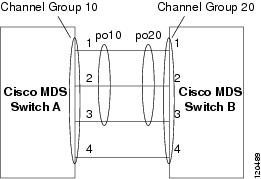To display the port channel configuration information, perform one of the following tasks:
|
Command
|
Purpose
|
|
show
port-channel
summary
|
Displays a summary of port channels within the switch. A one-line summary of each port channel provides the administrative
state, the operational state, the number of attached and active interfaces (up), and the first operational port (FOP). The
FOP is the primary operational interface that is selected in the port channel to carry control-plane traffic (no load-balancing).
The FOP is the first port that comes up in a port channel and can change if the port goes down. The FOP is also identified
by an asterisk (*).
|
|
show
port-channel
database
|
Displays the port channel that is configured in the On mode (default) and Active mode.
Cisco MDS NX-OS Release 8.4(2) and later: Displays the port channel that is configured in the On mode and Active mode (default).
|
|
show
port-channel
consistency
|
Displays
the consistency status without details.
|
|
show port-channel
consistency detail
|
Displays
the consistency status with details.
|
|
show port-channel usage
|
Displays the port channel usage.
|
|
show port-channel
compatibility-parameters
|
Displays the port channel compatibility.
|
|
show interface
fc
slot/port
|
Displays interfaces information.
|
|
show port-channel
database interface port-channel
number
|
Displays the specified port channel interface.
|
|
how running-config interface port-channelnumber
|
Displays the current running configuration for port-channel interface,
|
For detailed information about the fields in the output from these commands, refer to Cisco MDS 9000 Series NX-OS Command Reference Guide.
You can view specific information about existing port channels at any time from EXEC mode. The following show commands provide further details on existing port channels. You can force all screen output to go to a printer or save it
to a file. See Examples Displays the Port Channel Summary to Displays the Port Channel Summary.
Examples
switch# show port-channel summary
------------------------------------------------------------------------------
Interface Total Ports Oper Ports First Oper Port
------------------------------------------------------------------------------
port-channel 77 2 0 --
port-channel 78 2 0 --
port-channel 79 2 2 fcip200
Examples
switch# show port-channel database
port-channel1
Administrative channel mode is on
Last membership update succeeded
First operational port is fc1/19
4 ports in total, 2 ports up
Ports: fc1/19 [up] *
fc1/20 [up]
fc1/21 [down]
fc1/22 [down
port-channel2
Administrative channel mode is on
Last membership update succeeded
First operational port is fcip3
2 ports in total, 2 ports up
Ports: fcip1 [up]
fcip3 [up] *
Examples
switch# show port-channel database
port-channel1
Administrative channel mode is active
Last membership update succeeded
First operational port is fc1/19
4 ports in total, 2 ports up
Ports: fc1/19 [up] *
fc1/20 [up]
fc1/21 [down]
fc1/22 [down
port-channel2
Administrative channel mode is active
Last membership update succeeded
First operational port is fcip3
2 ports in total, 2 ports up
Ports: fcip1 [up]
fcip3 [up] *
Examples
The show port-channel consistency command has two options: without details and with details.
switch# show port-channel consistency
Database is consistent
Examples
switch# show port-channel consistency detail
Authoritative port-channel database:
================================================
total 1 port-channels
port-channel 100:
4 ports, first operational port is fc1/19
fc1/22 [down]
fc1/21 [down]
fc1/19 [up]
fc1/20 [up]
================================================
database 1: from module 1
================================================
total 1 port-channels
port-channel 100:
4 ports, first operational port is fc1/19
fc1/19 [up]
fc1/20 [up]
fc1/21 [down]
fc1/22 [down]
================================================
switch#
Examples
The show port-channel usage command displays details of the used and unused port channel numbers. switch# show port-channel usage
Totally 4 port-channel numbers used
===================================
Used : –77 -79, 100
Unused: 1 - 76, 80 – 99, 101 - 256
Examples
switch# show port-channel compatibility-parameters
physical port layer fibre channel or ethernet
port mode E/AUTO only
trunk mode
speed
port VSAN
port allowed VSAN list
Examples
switch# show interface fc1/1
fc1/1 is trunking
Hardware is Fibre Channel, FCOT is short wave laser
Port WWN is 20:0a:00:0b:5f:3b:fe:80
...
Receive data field Size is 2112
Beacon is turned off
Port-channel auto creation is enabled
Belongs to port-channel 123
...
Examples
switch# show port-channel database
interface port-channel 100
port-channel 100
Administrative channel mode is active
Last membership update succeeded
First operational port is fc1/19
4 ports in total, 2 ports up
Ports: fc1/19 [up] *
fc1/20 [up]
fc1/21 [down]
fc1/22 [down]
Examples
switch# show port-channel summary
------------------------------------------------------------------------------
Interface Total Ports Oper Ports First Oper Port
------------------------------------------------------------------------------
port-channel 1 1 0 --
port-channel 2 1 1 fc8/13
port-channel 3 0 0 --
port-channel 4 0 0 --
port-channel 5 1 1 fc8/3
port-channel 6 0 0 --










 Feedback
Feedback